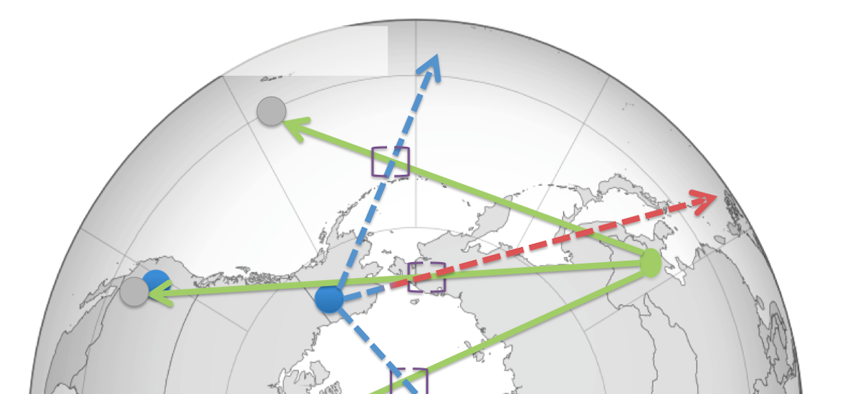
Depiction of ground based interceptor fired against an ICBM launched from North Korea. Joshua Pollack
If North Korea Fires an ICBM, the US Might Have to Shoot It Down Over Russia
Missile-defense physics may require interceptors to fly into ‘the teeth of the Russian early warning net.’
If Pyongyang fires a missile at the United States, its most-likely trajectory would take it over the North Pole. A U.S. attempt to shoot down that missile would probably occur within Russian radar space — and possibly over Russia itself. “It’s something we’re aware of,” Gen. Lori Robinson, who leads both U.S. Northern Command and the North American Aerospace Defense Command, or NORAD, said Wednesday. “It’s something we work our way through.”
By year’s end, the U.S. will have deployed 44 ground-based interceptors, or GBIs: 40 at Fort Greeley, Alaska, and four at Vandenberg Air Force Base, California. If deterrence fails, those interceptors would be the last line of defense against a North Korean missile. Each incoming ICBM might be met with four or more GBIs.
Last week, Joshua Pollack told an audience at the annual Air Force Association conference in Washington D.C. that the most probable intercept route aims the U.S. GBI “into the teeth of the Russian early warning net.”
The actual route will depend on the incoming missile’s course and speed, and just how quickly the U.S. system can react. Pollack, a researcher at the Middlebury Institute of International Studies at Monterey, elaborated in a subsequent writeup of his presentation. “Defending a West Coast target...means engaging the attacking [reentry vehicle] above the Russian Far East. Yikes.”
Robinson, in her remarks, was more guarded. “What you have to do is sit down and go, okay, what is the azimuth” — the direction of the object in the air from the perspective of the observer. The next question, she said, is: “When would be the right time to take the best shot to defend? That’s about all I’ll say.”
Related: How to Tell If North Korea and America Are Actually Headed to War
Related: No, We Cannot Shoot Down North Korea’s Missiles
Related: Could North Korea Shoot Down US Warplanes?
Cornell University arms researcher George Nelson Lewis offered another possibility: the most effective intercept course might actually engage the enemy missile on its way down, not rising from North Korea over Russia. “The slower closing speed allows more time for the interceptor to make the maneuvers to hit the target and thus allows less vigorous maneuvers to be made, which can be made more accurately,” Lewis said.
But Pollack pointed out that attempting to intercept the missile as early as possible on its flight path increases the odds of hitting it, especially if you have to take a second shot. “Take a West Coast scenario: if Alaska takes a head-on shot, engaging over Siberia, but misses, California might then have a chance before the [re-entry vehicle] gets to its target. But if Alaska shoots later, probably that’s the only chance,” he said.
The U.S. uses many different sensors to understand launch factors related to North Korean missiles. In a successful test of the GBI system in May, the Missile Defense Agency used infrared satellites to spot a test missile’s launch plume, then tracked it in flight with sea-based X-band radar, or SBX, and land-based TPY-2 radars.
Russia has been reluctant to concede that the Hwasong-14 missile that North Korea tested in July is an actual intercontinental ballistic missile. That suggests that if the U.S. spotted a launch and tried to intercept it, Russia might claim that the U.S. was acting provocatively and not in self-defense. The U.S. has attempted to ward off such claims; the GBI is specifically designed to be distinct from any missile that the United States would use to attack Russia. They don’t even carry an explosive warhead, instead destroying their target the same way a rock knocks a bird out of the sky — with a combination of mass and velocity. If you’re aiming to destroy anything other than a missile in flight, a GBI is a poor weapon.
Thomas Karako, a senior fellow at the international security program at the Center for Strategic and International Studies, said that U.S. is not — and should not — sweat the Russian response to a U.S. GBI launch. “The Russians, when they are honest, are pretty forthright about the fact that they don’t see this as any serious threat to their deterrent," Karako said. "You really have to drink the Kool-Aid of Russian propaganda to think that the GBIs in Alaska are a threat to Russia’s strategic deterrent.”
But the possibility of penetrating Russian airspace adds an extra complication to the question of how best to defend the United States from a growing North Korean threat — a threat that occupies more and more of Robinson’s time.
North Korean dictator Kim Jong-un has “ tested 30 percent more [nuclear weapons] than his father and grandfather combined,” she said at the National Defense Industrial Association's Women in Defense event. “You look at the speed of that and he’s not afraid to fail in public. We can see a ton of intent... But I can tell you, as head of Northern Command, I’m confident in our ability to defend the United States.”




